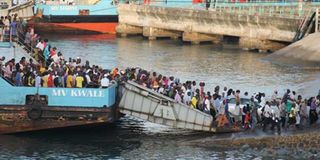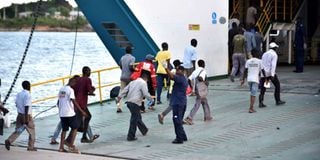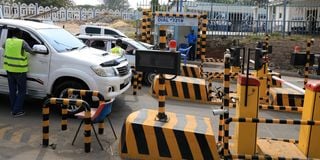Likoni ferry: Caught between competing interests of competency and efficiency

People disembark from MV Kwale ferry at the Likoni Channel.
A near drowning at the Likoni ferry crossing in Mombasa has thrown a spotlight on the competing interests of competence, efficiency and safety at the channel.
There were conflicting reports as to whether the 24-year-old woman slipped or jumped into the sea from the overcrowded ferry last weekend.
The woman was rescued last weekend by fishermen working near the ferry.
The chairman of the Kenya Ports Authority, Mr Benjamin Tayari, has rejected claims that the woman slipped, saying interrogations had revealed that she jumped from the vessel.
"We are sorry for what happened, but it had nothing to do with the ferries. We interrogated her and found that it had something to do with a mental problem," Mr Tayari said.
For the past two weeks, congestion has been the order of the day at the Likoni Channel, which is used by some 300,000 pedestrians and 6,000 vehicles a day.
Mr Tayari blamed the delays and congestion, especially over the weekend, on repairs to three ferries.
"The Likoni floating bridge was also closed for maintenance. It had mechanical problems, it got stuck at times and would not open. We foresaw a disaster because ships use the same route to enter and leave Kilindini Port. We do not know when the services will resume, but in the meantime we are trying to survive with the ferries," said Mr Tayari.

A Coast Guard officer beckons travellers boarding a ferry at Likoni crossing in March 2020.
He added: "Three of the vessels were out, but today we have five vessels in operation. Only the big one is waiting for spare parts from suppliers, but it will be back between today and tomorrow.
In a statement last week, the Kenya Ferry Service said: "We appreciate the frustration of motorists, but we are doing all we can to move traffic. 7am to 9am is the peak time for pedestrian traffic. For safety reasons, we are evacuating pedestrians first, not because motorists are not a priority, but because of the experience we have had. We are doing everything we can to normalise operations.
But what makes Likoni, on mainland Mombasa, so attractive to locals?
Every day for the past two weeks, Salim Ali has woken up at 5am to face his daily nightmare of crossing the channel by ferry.
He spends three to five hours covering a distance of less than 10 kilometres between his home and his job on Mombasa Island.
Ferry users crossing the Likioni channel at the Liwatoni Floating Bridge in Mombasa in this photo taken on 10th April 2021.
"I find the houses in Likoni very affordable compared to areas within Mombasa Island. I also do not have to spend money on fares," he says.
Mary Kadzo says the last two weeks have been a nightmare.
Kadzo works as a domestic helper in Mombasa and earns Sh7,000 a month. She pays Sh2,500 a month for a single room.
"It is not my wish to live in Likoni, but circumstances force me to. I have to budget for food, survival and my children's school fees, among other daily expenses. Do you think I could survive on that amount of money if I lived on the island?" asks Kadzo.
In addition to affordable housing, cheap land is another factor contributing to the high population in Likoni.
A number of homeowners have built their houses near the ocean, such as Shelly Beach and Mtongwe, where a 70 by 100 foot plot can go for as little as Sh400,000.
Mombasa County begins enforcing the Likoni floating Bridge usage for all passengers crossing the Likoni channel in a bid to control the spread of Covid-19 as shown in this photo taken on March 31, 2021.
Since operations at the Sh1.9 billion Likoni floating bridge were temporarily suspended last month for repairs, pedestrians and motorists have had to wait longer to cross.
When the bridge was operational, Salim would wake up around 8am, walk a kilometre across the Indian Ocean and be at his workplace on the island in an hour.
The current congestion at the channel has caused thousands of ferry users to alter their daily schedules.
When President Uhuru Kenyatta inaugurated the Sh1.9 billion Likoni Floating Bridge in 2020, the problem of congestion at the ferry crossing channel was supposed to be a thing of the past.
The construction of the 1.2-kilometre bridge was hailed by some Mombasa residents and tourists as one of Kenya's infrastructure milestones in 2020.
It was inaugurated by the President at the height of the Covid-19 pandemic, forcing security officials to announce the bridge's mandatory use as a way to curb the spread of the virus.
The bridge, which runs from Liwatoni to Bofu, was opened to the public on Christmas Day. Hundreds of people took the opportunity to snap photos to capture the moment.
The bridge, the first of its kind in East and Central Africa, has a six-metre wide deck and a 715-metre long floating section.

Motorists at the Likoni Ferry Crossing in Mombasa use a cashless payment system. Once payment is done, the new system captures the vehicle’s number plate, and once approved, the barrier gate will automatically open to let the driver through.
The middle section has a 150-metre sliding gate that opens and closes as ships enter and leave the port of Mombasa.
But its closure means ferry users are back to dealing with constant congestion, long queues, sexual assaults and sometimes stampedes at the Likoni ferry crossing.





